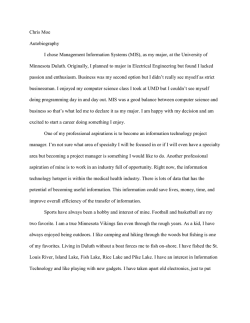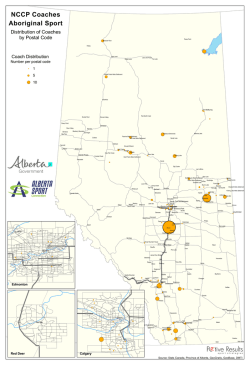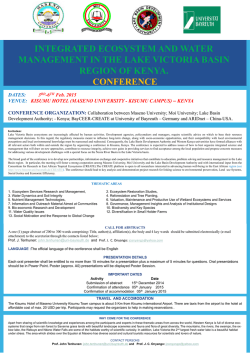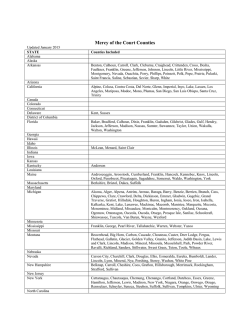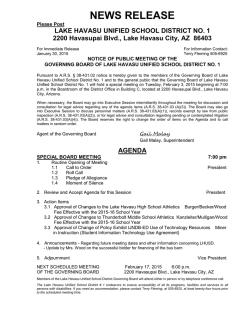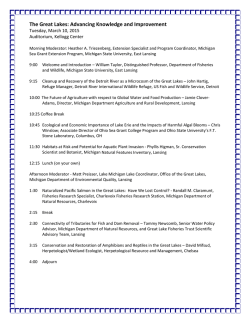
Glacial Lake Outburst Floods in the Cordillera Apolobamba, Bolivia
Glacial Lake Outburst Floods in the Cordillera Apolobamba, Bolivia: Fieldwork report By Kathryn Robertson Geography student at the University of Cambridge, UK Overview For my final year dissertation in Geography at the University of Cambridge, I am researching glacial lake outburst floods (GLOFs) in Bolivia. As part of this research, I carried outsix days of fieldwork in the Pelechuco valley, Cordillera Apolobamba, La Paz department, Bolivia (Figure 1). Fieldwork was planned with the assistance of Dirk Hoffman and Rodrigo Tarquino at the Bolivian Mountain Institute (BMI) in La Paz. This report will outline the context for this research, my fieldwork activities and some preliminary results. Glacial lake Pelechuco valley Agua Blanca village Pelechuco village Figure 1.Location of the glacial lake in relation to Agua Blanca and Pelechuco villages (main image).Location of Pelechuco in Bolivia (inset). Sources: Google Earth; Wikimedia commons. 1. Context Glacial lakes Glacial lakes are common in glaciated mountain regions such as the Himalaya and Andes. They form when meltwater from glaciers ponds up behind an ice mass or glacial debris, which acts as a dam and contains the water. Climate change is enhancing glacial retreat in many high mountain regions (Vaughan et al. 2013), and in response, glacial lakes are increasing in volume and number (Richardson & Reynolds 2000). This increases the risk of Glacial Lake Outburst Floods (GLOFs). GLOFs occur when the water level in a glacial lake exceeds the height of the dam, or when a trigger mechanism (such as an ice, snow or rock avalanche) generates an impact wave that overtops the dam (Kaab et al. 2005). Overflowing water can then erode the dam and cause it to fail, leading to lake drainage and flooding of the river fed by the glacial lake. The process of the formation, enlargement and flooding of glacial lakes dammed by glacial debris is shown in Figure 2(Awal et al. 2010). Figure 2The formation, enlargement and flooding of glacial lakes dammed by glacial debris. As glaciers advance, they push debris downslope. If the glacier then retreats, it leaves a pile of debris called an ‘end moraine’ (a & b). The basin between the glacier and the end moraine tends to fill with meltwater from the glacier and rainwater (c), forming a lake dammed by the end moraine. If the glacier retreats further, the lake enlarges. Overflowing of the lake or erosion of the dam causes water from the lake to drain, creating a flood (GLOF) (e). Source: (Awal et al. 2010). GLOFs are an important area of research because of their potential dangers for human populations. GLOFs can reach discharges of up to 30,000ms-1 and travel distances of over 200km, and where the river valley is populated, they have been known to cause significant damage to infrastructure, agricultural land and even loss of life (Richardson & Reynolds 2000). However, the risk of damage to human populations from GLOFs has been successfully reduced in the past, for example by draining potentially dangerous glacial lakes (Carey et al. 2012) or stabilising moraine dams (McKillop & Clague 2007). Management of GLOF risk can be aided by effective hazard assessment of glacial lakes. Studies have focused on mapping glacial lakes, monitoring their expansion, simulating potential outburst floods and assessing their damage potential for nearby settlements (Huggel et al. 2004). Remote sensing has become an invaluable tool for researching GLOFs, given that the affected areas are often remote and expensive or dangerous to undertake fieldwork in (Kaab et al. 2005). Glacial lakes have been detected on a regional scale using satellite imagery (Raj, Kumar & Remya 2013; Mergili & Schneider 2011). Potentially hazardous lakes have then been identified based on recent expansion rates (Wang et al. 2012b). Dam-breach and hydrologic/hydraulic models have been applied to particular lakes to predict the extent and depth of a potential flood, using digital elevation models supplemented with in situ field measurements (Shrestha & Nakagawa 2013; Zaidi, Yasmeen & Siddiqui 2013) 2013).. Geographical Information Systems (GIS) have been used to create integrated risk maps, combining the results of hydrologic/hydraulic models with socio-economic economic characteristics such as settlements and social vulnerability (Zaidi, Yasmeen & Siddiqui 2013; Hegglin & Huggel 2008) 2008). GLOFs in the Cordillera Apolobamba However, much of this research has been focused on the Himalayas, European Alps, or Peruvian Cordillera Blanca. This project focuses on the Bolivian Andes, because despite recent glacier decline (Soruco et al. 2009) 2009), there has been little research into the consequences of glacier retreat (Hoffmann 2008),, particularly the development of glacial lakes and their potential for GLOFs. The Cordillera Apolobamba is a 75 km km-long mountain chain forming the Northern part of the Cordillera Oriental, Bolivia’s Eastern Andean mountain chain (Hoffman & Weggenmann 2013).. GLOFs in this region are no longer merely a theoretical possibility; in 2009, a glacial lake above the village of Ke Keara ara drained and flooded the valley downstream, cutting off road communication for several months (Hoffman & Weggenmann 2013).. Consequently, glacial lakes have been incorporated into the Apolobamba National Park’s monitoring sch scheme (Hoffman 2010).. In 2011, Daniel Weggenmann (University of Heidelberg) made an inventory of the Apolobamba’s glacial lakes as part of his graduate thesis, determining their size, dam material, growth rates and risk potential (Hoffman & Weggenmann 2013) 2013).However, .However, there have been no further modelling studies of possible GLOFs or hazard mapping from dangerous lakes. 2. Project outline The aim of this project is to build on the regional hazard assessment made by Weggenmann by investigating in more detail the hazard potential of one particular lake, PEL_ORCO_002 (Figure 3).. This lake was chosen for further investigation primarily because of the potential impact on human populations. The lake feeds a stream which runs through the Pelechuco valley. Two villages are located in this valley: Agua Blanca and Pelechuco. There is also an important access road running through the valley, at some points adjacent to the river. Figure 3 Lake PEL_ORCO_002 It is difficult to calculate the outburs outburstt probability of glacial lakes, because outburst out floods are rare, limiting our understanding of failure processes, and there are numerous possible trigger mechanisms and moraine dam forms forms(McKillop & Clague 2007). 2007) Therefore this project will focus on the potential impact of an outburst flood, rather than its likelihood. This project has two main objectives: 1. Determine a likely range of flood volumes for a potential outburst flood from lake PEL_ORCO_002. 2. Using those flood volumes, use the computational model HEC_RAS to create a possible range of flood inundation scenarios. 3. Fieldwork To estimate the volume of the lake, and therefore determine a likely range of flood volumes, area measurements of the lake were required. In order to carry out the flood modelling using HEC_RAS, detailed geometric data of the valley and stream between the lake and Pelechuco were required. While these data could be obtained remotely, using satellite images such as Landsat andsat ETM+ to calculate lake area and a Digital Elevation Model (DEM) to obtain the geometric information, the resolution of this data would not be high enough by itself to provide an accurate estimate of lake area and valley geometry. Therefore, fieldwork ork was undertaken to measure lake area and valley geometry at a higher resolution. To collect the data, six days were spent undertaking fieldwork in the Pelechuco valley. I stayed in the tourist albergue in Agua Blanca (Figure 4), 4) with logistical assistance ce from Dirk Hoffman and RodriguoTarquino at tthe he Bolivian Mountain Institute. Figure 4 The tourist albergue in Agua Blanca The area of the lake PEL_ORCO_002 was measured using a handheld Garmin GPS unit. This required walking around the lake holding the GPS device in ‘Track’ mode (Figure 5),, and later uploading the GPS points to a computer. Figure 5 Measuring lake area Valley and stream geometry data were obtained by measuring the cross cross-section section of the river and valley at 14 locations. A 50m tape pe measure was placed across the stream and valley perpendicular to the flow, and depths to the ground were measured using a pole and tape measure (Figure 6) 6). Figure 6 Measuring the stream and valley cross cross-section 4. Preliminary observations The potential impact of an outburst flood from lake PEL_ORCO_002 cannot be assessed until the modelling work has been completed. However, some preliminary observations may be made. The glacier feeding the lake has decoupled from the water surface (Figure 7), which may reduce lake growth rates in the future and decrease the maximum potential flood volume. However, the retreating glacier still poses a risk for lake flooding since large blocks of ice may break off and fall into the lake, creating a displacem displacement ent wave that may overtop rtop and erode the moraine dam, causing it to fail. Glacier decoupled from the lake surface Figure 7 Glacier decoupled from lake surface There is already a breach in the moraine dam, suggesting than a small outburst flood may have occurred in the past. Because there is already a stream draining the lake, a sudden total lake drainage event is probably unlikely. However, a large volume of water might still exist the lake in the case of failure of the moraine dams on either side of the breach, which may occur as a result of a displacement wave (as outlined above) or as a result of the melting of ice cores inside the moraine dam. Further geophysical investigations would be needed to ascertain whether ice cores are present in the moraine dam. Breach in the moraine dam Figure 8 Breach in the moraine dam 5. Next steps The lake area data will be used to calculate a range of potential flood volume scenarios. These will then be used to determine a possible range of flood inundation scenarios using computational modelling. It is hoped that this information will help contribute to hazard assessment and management of outburst floods in the Pelechuco valley. However, the results of this study must only be considered as preliminary, and not deterministic. This project does not fully investigate the mechanisms by which the moraine dam may be breached, and does not give any indication of the likelihood of an outburst flood. Further research will be needed to explore these areas more fully. Acknowledgments Many thanks go to Dirk Hoffman and RodriguoTarquino at the Bolivian Mountain Institute for their invaluable help and advice, both in the formulation of this project, and in the logistics of undertaking fieldwork in Apolobamba. I would also like to thank the people of Agua Blanca and Pelechuco for their hospitality and generosity in allowing us to carry out research on their land. Finally, thanks go to my Dad, Eddie Robertson, for agreeing to be my research assistant and making this trip possible. References Awal, R, Nakagawa, H, Fujita, M, Kawaike, K, Baba, Y & Zhang, H 2010, 'Experimental Study on Glacial Lake Outburst Floods Due to Waves Overtopping and Erosion of Moraine Dam', Annuals of Disaster Prevention Research Institute, Kyoto University, vol 53, no. B, pp. 583-594. Carey, M, Huggel, C, Bury, J, Portocarrero, C & Haeberli, W 2012, 'An integrated socioenvironmental framework for glacier hazard management and climate change adaptation: lessons from Lake 513, Cordillera Blanca, Peru', Climatic Change, vol 112, no. 3-4, pp. 733-767. Hegglin, E & Huggel, C 2008, 'An Integrated Assessment of Vulnerability to Glacial Hazards A Case Study in the Cordillera Blanca, Peru', Mountain Research and Development, vol 28, no. 3-4, pp. 299-309. Hoffman, D 2010, 'Participatory Glacier Lake Monitoring in Apolobamba Protected Area. A Bolivian Experience', Education 2010. Hoffmann, D 2008, 'Consecuencias del retroceso glaciar en la Cordillera boliviana', Pirineos, vol 16, pp. 77-84. Hoffman, D & Weggenmann, D 2013, 'Climate Change Induced Glacier Retreat and Risk Management: Glacial Lake Outburst Floods (GLOFs) in the Apolobamba Mountain Range, Bolivia', in WL Filho (ed.), Climate Change and Disaster Risk Management, Springer Berlin Heidelberg, Heidelberg, New York, Dordrecht, London. Huggel, C, Haeberli, W, Kaab, A, Bieri, D & Richardson, S 2004, 'An assessment procedure for glacial hazards in the Swiss Alps', Canadian Geotechnical Journal, vol 41, pp. 10681083. Kaab, A, Huggel, C, Fischer, L, Guex, S, Paul, F, Roer, I, Salzmann, N, Schlaefli, S, Schmutz, K, Schneider, D, Strozzi, T & Weidmann, Y 2005, 'Remote sensing of glacier- and permafrost-related hazards in high mountains: an overview', Natural Hazards and Earth System Science, vol 5, no. 4, pp. 527-554. McKillop, R & Clague, J 2007, 'A procedure for making objective preliminary assessments of outburst flood hazard from moraine-dammed lake in southwestern British Columbia', Natural Hazards, vol 41, pp. 131-157. Mergili, M & Schneider, J 2011, 'Regional-scale analysis of lake outburst hazards in the southwestern Pamir, Tajikistan, based on remote sensing and GIS', Natural Hazards and Earth System Sciences, vol 11, no. 5, pp. 1447-1462. Raj, K, Kumar, K & Remya, S 2013, 'Remote sensing-based inventory of glacial lakes in Sikkim Himalaya: semi-automated approach using satellite data', Geomatics Natural Hazards & Risk, vol 4, no. 3, pp. 241-253. Richardson, S & Reynolds, J 2000, 'An overview of glacial hazards in the Himalayas', Quaternary International, vol 65-66, pp. 31-47. Shrestha, B & Nakagawa, H 2013, 'Assessment of potential outburst floods from the Tsho Rolpa glacial lake in Nepal', Natural Hazards, pp. 1-24. Soruco, A, Vincent, C, Francou, B & Francisco, J 2009, 'Glacier decline between 1963 and 2006 in the Cordillera Real, Bolivia', Geophysical Research Letters, vol 36, no. 3. Vaughan, D, Comiso, J, Allison, I, Carrasco, J, Kaser, G, Kwok, R, Mote, P, Murray, T, Paul, F, Ren, J, Rignot, E, Solomina, O, Steffen, K & Zhang, T 2013, 'Observations: Cryosphere', in T Stocker, DPG Qin, M Tignor, S Allen, J Boschung, A Nauels, Y Xia, V Bex, P Midgley (eds.), Climate Change 2013: The Physical Science Basis. Contribution of Working Group 1 to the Fifth Assessment Report of the Intergovernmental Panel on Climate Change, Cambridge University Press, Cambridge and New York. Wang, W, Yao, T, Yang, W, Joswiak, D & Zhu, M 2012b, 'Methods for assessing regional glacial lake variation and hazard in the southeastern Tibetan Plateau: a case study from the Boshula mountain range, China', Environmental Earth Science, vol 67, no. 5, pp. 1441-1450. Zaidi, A, Yasmeen, Z & Siddiqui, M 2013, 'Glacial Lake Outburst Flood (GLOF) risk mapping in Hunza River Basin (Pakistan) using geospatial techniques', in Recent Advances in Space Technologies (RAST), 2013 6th International Conference on, IEEE, Instanbul.
© Copyright 2025
